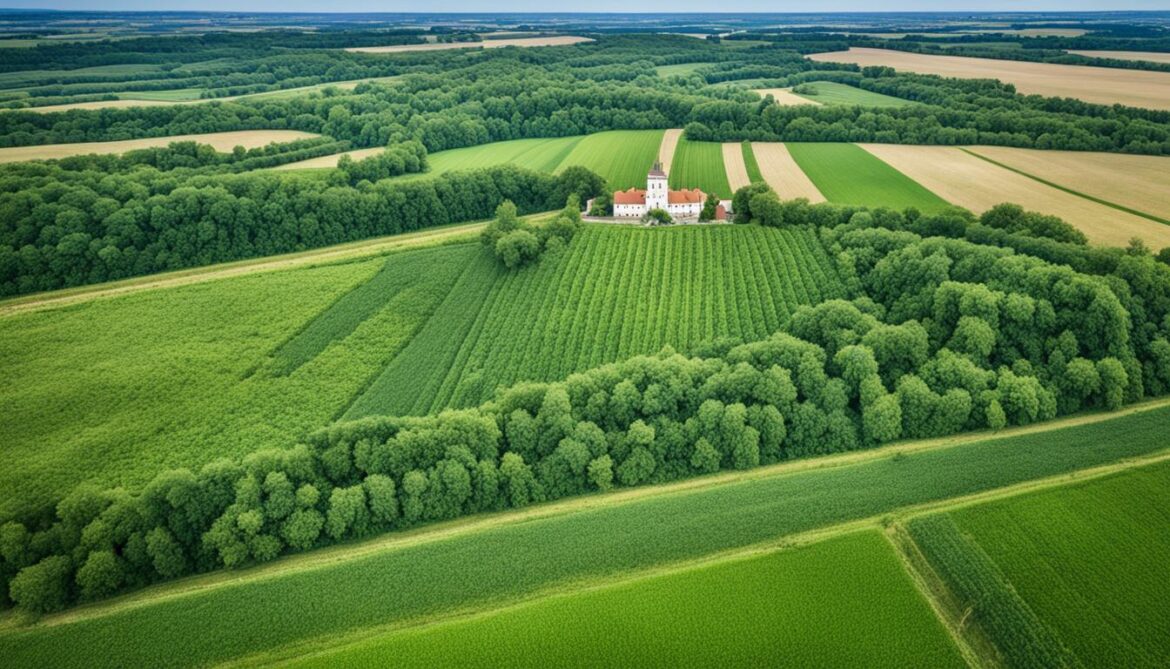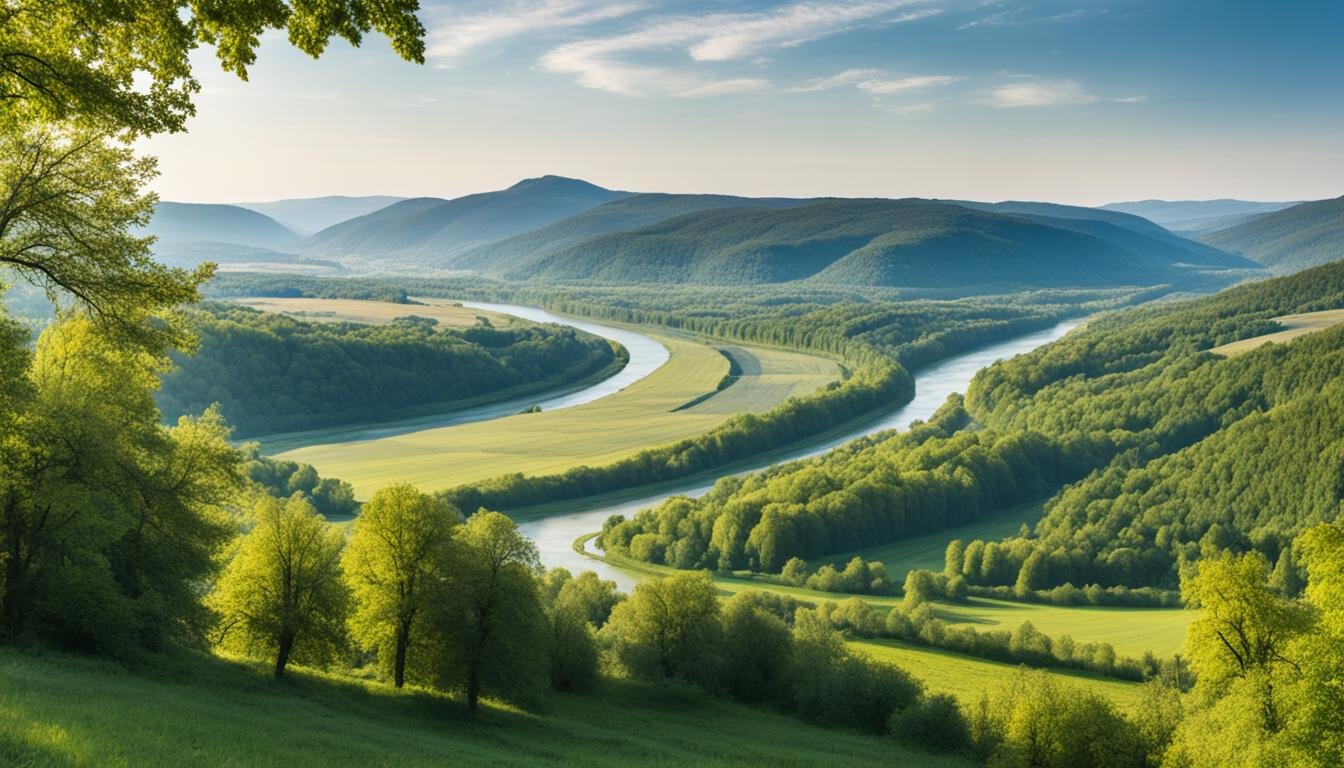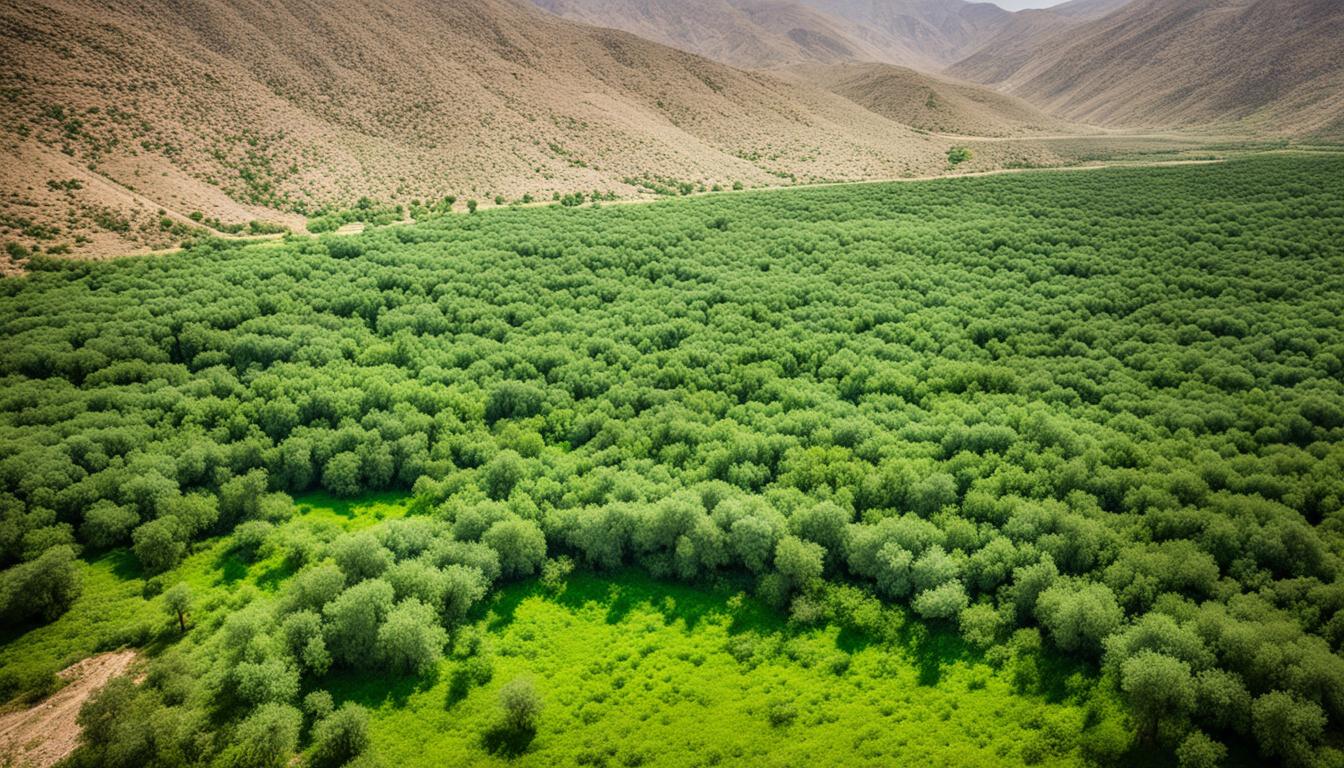Hungary Sacred Natural Sites and Biodiversity
Did you know that Hungary boasts a staggering 22% of its territory as protected areas, including sacred natural sites and nature reserves? This stunning statistic speaks to the country’s unwavering commitment to biodiversity conservation and the preservation of its natural heritage.
Over the years, Hungary has experienced significant changes in land use, with the abandonment of arable lands and an increase in forest area. The country’s forests, comprising more than 57% of the total forest area, are predominantly made up of indigenous tree species. Hungary is also home to a remarkable diversity of species, with over 53,000 described species, 82% of which are animals.
With 46 endangered habitat types listed in the EU Habitats Directive, Hungary recognizes the importance of protecting its unique ecosystems. The establishment of protected areas has been a cornerstone of conservation efforts, ensuring the preservation of biodiversity and providing habitat for endangered species.
Key Takeaways:
- Hungary has 22% of its territory designated as protected areas, including sacred natural sites and nature reserves.
- The country’s forests are predominantly composed of indigenous tree species, accounting for over 57% of the total forest area.
- Hungary is home to over 53,000 described species, with animals making up 82% of the total.
- The country has 46 endangered habitat types listed in the EU Habitats Directive.
- Protected areas play a crucial role in conserving biodiversity and providing habitat for endangered species.
Status and Trends of Biodiversity in Hungary
The status and trends of biodiversity in Hungary reveal both positive and negative aspects. Over the years, Hungary has witnessed a reduction in agricultural intensification, resulting in an increase in forest area. This development has been promising for Hungary’s efforts in biodiversity conservation and environmental protection. However, challenges remain as traditional land use forms have been lost, and certain habitat types continue to decline. To gain a deeper understanding, let’s delve into the details of Hungary’s biodiversity status and trends.
Conservation Status of Endangered Habitats
In Hungary, the conservation status of 67% of the listed endangered habitats is considered bad. This highlights the significant work required to protect and restore these habitats. Encouragingly, the remaining 33% have a favorable conservation status, indicating successful conservation efforts. However, further action is necessary in order to ensure the long-term survival of these habitats. By focusing efforts on biodiversity conservation and habitat restoration, Hungary can continue to safeguard its natural heritage.
Endangered Species and Global Significance
An evaluation of Hungary’s biodiversity reveals that 17% of evaluated species are classified as endangered at the global level. This underscores the importance of protecting and preserving these species to maintain global biodiversity. By prioritizing conservation initiatives, Hungary can contribute significantly to international efforts in wildlife preservation.
Conservation Importance of Grasslands
Grasslands cover 10.8% of Hungary’s territory and play a vital role in biodiversity conservation. These natural habitats are of great conservation importance, hosting a diverse range of plant and animal species. Hungary recognizes the value of grasslands and has included them in the Natura 2000 network, further enhancing their protection. By safeguarding these critical ecosystems, Hungary can ensure the preservation of its unique biodiversity.
Threats to Inland Biodiversity
Hungary’s inland biodiversity faces significant threats, including habitat loss and water quality issues. The destruction of habitats due to human activities such as urbanization and industrialization poses a severe risk to the country’s wildlife. Additionally, water bodies are affected by pollution and inadequate water supply, further endangering aquatic species. It is imperative for Hungary to address these threats and implement robust conservation measures to protect its inland biodiversity for future generations.
| Biodiversity Status | Challenges |
|---|---|
| Reduction in agricultural intensification | Loss of traditional land use forms |
| Increase in forest area | Decline of certain habitat types |
| 67% of listed endangered habitats have bad conservation status | Conservation of endangered habitats |
| 17% of evaluated species globally endangered | Protection of endangered species |
| Grasslands cover 10.8% of territory | Conservation of grassland ecosystems |
| Habitat loss and water quality issues | Preservation of inland biodiversity |
Protected Areas in Hungary
Hungary has demonstrated a strong commitment to preserving its natural heritage by establishing protected areas throughout the country. These protected areas have significantly increased the amount of territory under conservation, surpassing the EU average by expanding from 9.4% to 22%.
These protected areas encompass a diverse range of sites, including sacred natural sites, natural heritage sites, and ecological sanctuaries. They have a vital role in safeguarding the country’s biodiversity, providing essential habitats for endangered species, and promoting sustainable land use practices.
The management of these protected areas is guided by a combination of national and EU legislation, ensuring the harmonization of efforts to balance the economic and protective functions of forests. It is through strategic coordination and collaboration that Hungary strives to achieve successful biodiversity conservation.
These protected areas not only serve as havens for wildlife, but they also offer invaluable opportunities for research, education, and recreation. Visitors have the chance to immerse themselves in the natural splendor of Hungary’s ecological sanctuaries, fostering a deeper understanding and appreciation for the country’s rich natural heritage.
Examples of Protected Areas in Hungary:
- Hortobágy National Park: Located in the Great Hungarian Plain, Hortobágy National Park is a UNESCO World Heritage Site and serves as an important breeding ground for numerous bird species.
- Bükk National Park: Covering the Bükk Mountains, Bükk National Park is renowned for its diverse flora and fauna, including over 80 orchid species and 200 bird species.
- Duna-Dráva National Park: Situated along the Danube and Dráva rivers, Duna-Dráva National Park boasts wetlands, floodplains, and forests, providing critical habitat for various species, including the Eurasian otter and the white-tailed eagle.
To illustrate the significance of protected areas in Hungary, the table below showcases some of the notable ecological sanctuaries in the country:
| Protected Area | Location |
|---|---|
| Kiskunság National Park | Central Great Hungarian Plain |
| Balaton Uplands National Park | Transdanubian Mountains |
| Fertő-Hanság National Park | Western border region |
Endangered Species in Hungary
Hungary is home to a wide range of endangered species, with 3% of the total number of species protected under national law. The conservation initiatives in Hungary aim to protect these endangered species and their habitats.
The population trends of evaluated animal and plant species reveal that 32% of these populations are experiencing a decline. However, there are also positive trends that provide hope for the conservation efforts. For example, the population of the Great Bustard and the Imperial Eagle has shown an increase in recent years.
To safeguard the endangered species, Hungary has implemented various conservation initiatives. Captive breeding programs are being carried out to help increase the population of threatened species. Additionally, reintroduction efforts are being undertaken to restore endangered species to their natural habitats. These initiatives play a vital role in the protection and preservation of Hungary’s wildlife.
In recognition of the importance of Hungary’s wildlife habitats, the country has established protected areas to safeguard the endangered species and their ecosystems. These protected areas provide a safe haven for vulnerable species and contribute to the overall conservation efforts of the country.

Conservation Initiatives in Hungary
Hungary’s commitment to biodiversity conservation is evident through its conservation initiatives. These initiatives aim to preserve the natural habitats of endangered species and promote the sustainable use of resources.
“Our conservation initiatives focus on safeguarding Hungary’s unique wildlife and ensuring their habitats remain protected for future generations.” – Hungarian Minister of Environment and Sustainability
The conservation programs in Hungary involve collaboration between government agencies, non-governmental organizations, and local communities. These partnerships help mobilize resources, raise awareness, and implement effective conservation strategies.
Protecting Hungarian Wildlife Habitats
Hungarian wildlife habitats are diverse and varied, ranging from wetlands to forests and grasslands. These habitats are essential for supporting a wide array of plant and animal species.
The conservation initiatives in Hungary aim to protect and restore these habitats by implementing sustainable land management practices and promoting responsible use of natural resources. This includes measures such as habitat restoration, conservation zoning, and wildlife monitoring.
The establishment of protected areas, such as national parks and nature reserves, is a key strategy in conserving Hungarian wildlife habitats. These protected areas provide a refuge for endangered species and allow for the preservation of their natural ecosystems.
Grasslands and their Conservation Importance in Hungary
Grasslands cover 10.8% of Hungary’s territory and play a vital role in biodiversity conservation, making them of great importance within Europe. These diverse ecosystems are included in the Natura 2000 network, a network of protected areas across the European Union. Hungary’s grasslands often exhibit higher biodiversity compared to those found in other countries.
Traditional herding practices, such as extensive grazing by livestock, have been crucial for the maintenance and preservation of grassland ecosystems. Grazing helps control the growth of woody plants, promoting the growth of diverse herbaceous vegetation. This balanced ecosystem supports a wide range of plant and animal species, including rare and endemic species that are unique to these grasslands.
However, changes in land use and the decrease in grazing animals have posed challenges to the conservation of these valuable grassland habitats. Modern agricultural practices and urbanization have resulted in the conversion of grasslands into cultivated lands or urban areas, leading to habitat loss and fragmentation.
Efforts are being made to protect and restore these grassland ecosystems in Hungary. Strictly protected grassland species, such as the Hungarian meadow viper, are of high conservation value. Captive breeding and reintroduction programs are being implemented to ensure their survival and prevent their extinction.
“Grasslands are a critical component of Hungary’s natural heritage, and their conservation is of utmost importance for maintaining biodiversity. We must continue to prioritize the protection and restoration of these unique ecosystems to safeguard the rich plant and animal life they support.”
To raise awareness about the conservation importance of grasslands, educational programs and initiatives are being undertaken. These aim to highlight the ecological value of these habitats and encourage sustainable land use practices that support their conservation.
Preserving Hungary’s grasslands not only benefits the country but also contributes to the global effort of biodiversity conservation. These unique and diverse ecosystems are a testament to Hungary’s commitment to safeguarding its natural heritage and ensuring a sustainable future for generations to come.
Forests and their Role in Biodiversity Conservation
Forests play a significant role in biodiversity conservation in Hungary. Covering 20.3% of the country’s territory, these forests are predominantly made up of indigenous tree stocks, accounting for a diverse range of species and habitats. Approximately 37% of Hungary’s forests are considered semi-natural, providing a rich and valuable ecosystem.
In addition to their contribution to biodiversity, forests also play a crucial role in the provision of ecosystem services. They support clean air and water, regulate climate, and provide habitats for a wide array of flora and fauna. Forests are vital for maintaining the balance of ecosystems and supporting the overall health of the environment.
The management of forests entails a delicate balance between economic considerations and the conservation of biodiversity. Some forests in Hungary serve various functions, including healthcare, tourism, education, and research. These multifunctional forests demonstrate the diverse benefits they offer to both humans and nature.
The alignment of Hungary’s forest management with EU legislation on protected areas has significantly contributed to increasing the total territory under protection. This commitment to conservation ensures the preservation of Hungary’s natural heritage sites and the safeguarding of its unique biodiversity.

Forest Biodiversity in Hungary
Forests in Hungary are home to numerous species, highlighting their importance in maintaining biodiversity. From majestic oak and beech trees to vibrant understory vegetation, forests provide a diverse range of habitats for various plants and animals.
“Hungary’s forests offer critical habitats for numerous species, protecting them from threats such as habitat loss and fragmentation. They provide refuge for endangered animals, including the European brown bear and the lesser spotted eagle.” – Hungarian Forest Society
The Challenges of Forest Conservation
Despite the significance of forests in biodiversity conservation, several challenges need to be addressed. Human activities such as deforestation, illegal logging, and habitat destruction continue to threaten forest ecosystems in Hungary.
Climate change also poses a significant challenge to forest conservation. Rising temperatures, changes in precipitation patterns, and the increased occurrence of extreme weather events can impact the health and resilience of forest ecosystems.
Conservation Initiatives
To address the challenges faced by forests and promote their conservation, Hungary has implemented various initiatives. These include:
- The identification and protection of high conservation value forests
- Improving sustainable forest management practices
- Promoting forest restoration and reforestation
- Engaging local communities in forest conservation efforts
Water Bodies and their Conservation Status in Hungary
Hungary is blessed with numerous freshwater surface bodies and groundwater bodies, contributing to its rich biodiversity. However, the conservation status of these water bodies varies, with some facing risks due to organic, nutrient, or priority hazardous substances. Although the water quality of big rivers remains acceptable, small bodies of water often experience higher pollutant loads, posing challenges to their ecological health.
Efforts have been undertaken to improve the conservation status of water bodies in Hungary, particularly big lakes like Lake Balaton. The country has implemented water-quality protection strategies and environmental investment programs to enhance the ecological condition of these significant water resources.
| Water Body | Conservation Status |
|---|---|
| River Danube | Well-preserved |
| Lake Balaton | Improving due to conservation initiatives |
| Small bodies of water | Vulnerable to increased pollutant loads |
Despite these conservation efforts, water bodies in Hungary still face threats. Inadequate water supply and the uncontrolled use of water resources put further strain on the fragile aquatic ecosystems. The preservation and sustainable management of these valuable water resources require ongoing commitment to environmental protection and conservation initiatives.

The Importance of Water Resources
“Water is essential for supporting life and maintaining the balance of ecosystems. We must strive to protect and conserve our water bodies for the well-being of present and future generations.”
Agriculture and Crop Diversity in Hungary
Agriculture plays a significant role in Hungary, with 62.4% of the country’s land being used for agricultural purposes. The country’s commitment to environmental protection and conservation initiatives is evident in its diverse agricultural practices and crop varieties.
The high diversity of local crop types and landraces makes Hungary a secondary center of crop diversity. The natural flora of the country provides a rich source of wild fruits, medicinal plants, forage grasses, and crop wild relatives. These genetic resources are crucial for the future resilience of agricultural systems, as they possess unique traits that can contribute to adaptation to changing environmental conditions.
Hungary actively conserves its agricultural genetic resources through gene banks, which house and safeguard plant and micro-organism genetic materials. This conservation effort ensures the availability of diverse genetic resources for future generations.
To support agricultural diversity, Hungary encourages the registration of cultivars, which are cultivated varieties of plants. Despite a slight decrease in the number of taxa, the number of registered cultivars has increased over the years. This signifies an ongoing commitment to maintaining and promoting crop diversity within the agricultural sector.
Furthermore, organic farming has witnessed growth in Hungary, encompassing 1.3% of the country’s territory. Organic farming practices prioritize the use of environmentally friendly techniques and contribute to the conservation of agricultural biodiversity. However, the growth of organic farming has stagnated in recent years, highlighting the need for continued support and initiatives to promote sustainable and organic agricultural practices.

Crop Diversity Data in Hungary:
| Crop Type | Number of Varieties |
|---|---|
| Wheat | 329 |
| Maize | 207 |
| Potatoes | 198 |
| Apples | 127 |
| Cherries | 95 |
| Grapes | 84 |
Table: Crop diversity data in Hungary – Number of varieties for selected crops.
In conclusion, Hungary recognizes the importance of agriculture and crop diversity in environmental protection and conservation efforts. By preserving indigenous crop varieties, promoting organic farming, and conserving genetic resources, Hungary is actively working towards maintaining agricultural biodiversity and ensuring sustainable food production for future generations.
Threats to Biodiversity in Hungary
Human activity poses significant threats to biodiversity in Hungary. Economic development, invasive alien species, habitat fragmentation, and climate change are among the main drivers of biodiversity loss. These factors have a direct impact on the country’s efforts towards biodiversity conservation, environmental protection, and the preservation of protected areas.
Economic development, while essential for a country’s progress, often comes at the expense of natural habitats and ecosystems. The expansion of urban areas, industrial activities, and infrastructure development leads to the destruction and fragmentation of wildlife habitats, endangering numerous species that rely on these habitats for their survival.
“The loss of natural habitats due to economic development threatens Hungary’s biodiversity and undermines the efforts made to protect the country’s ecological sanctuaries and sacred natural sites.”
Invasive alien species pose another significant threat to Hungary’s biodiversity. These species, introduced from other regions, often outcompete native species for resources, disrupt natural ecosystems, and can even drive native species to extinction. The spread of these species, whether terrestrial or aquatic, poses challenges to the conservation of native flora and fauna.
Habitat fragmentation, a consequence of human activities such as agriculture, deforestation, and infrastructure development, isolates wildlife populations, restricts their movement, and reduces genetic diversity. Fragmented habitats are more susceptible to other threats, such as invasive species, poaching, and diseases, exacerbating the risk of biodiversity loss.
Climate change presents one of the most pressing threats to biodiversity worldwide. Rising global temperatures, extreme weather events, and changes in precipitation patterns impact ecosystems, alter habitats, and disrupt the intricate balance of species interactions. Hungarian ecosystems are not immune to these changes, with consequences for the survival and distribution of native species.
Clear-cutting in forests, the overpopulation of game animals in certain areas, and the spread of alien tree species contribute to the threats faced by forest biodiversity in Hungary. Forests, which play a crucial role in preserving biodiversity, are under pressure due to unsustainable logging practices, uncontrolled hunting, and the encroachment of non-native tree species.

Inland biodiversity in Hungary is also affected by habitat loss, inadequate water supply, and the uncontrolled use of water resources. Wetlands, rivers, and other freshwater habitats face degradation and pollution, impacting the survival of aquatic species. The loss of wetlands due to drainage for agriculture and urbanization further exacerbates the problem.
The geographical characteristics of the Carpathian basin make Hungary particularly vulnerable to transboundary environmental impacts. Cross-border issues, such as pollution, invasive species, and climate change effects, require international cooperation and holistic approaches to ensure effective biodiversity conservation.
Importance of Indigenous and Local Knowledge in Biodiversity Conservation
Indigenous and local knowledge (ILK) holders in Hungary have a wealth of information about the local biodiversity and ecosystem services. Their deep-rooted knowledge and practices are invaluable in contributing to the sustainable management of biodiversity and the conservation of natural heritage sites.
ILK holders play a crucial role in identifying harmful policies and drivers that impact biodiversity, as well as providing insights into more sustainable resource use. Their understanding of traditional land use practices, seasonal variations, and species interactions can inform conservation strategies and support the effective protection of Hungary’s protected areas and natural heritage sites.
“Incorporating indigenous and local knowledge into conservation efforts allows for a holistic understanding of the environment and helps in identifying conservation priorities.”
The co-production of knowledge between ILK holders and scientists can lead to the generation of new knowledge that benefits both parties. By combining traditional wisdom with scientific research, innovative approaches to biodiversity conservation can be developed. This collaboration enhances the effectiveness of conservation practices and ensures that they are culturally appropriate and locally relevant.
Policies and regulations should respect and incorporate the diversity of local knowledge and value systems. It is vital to engage with ILK holders in decision-making processes, empowering them to actively participate in biodiversity conservation efforts. Their perspectives and insights contribute to a more comprehensive understanding of the environment, fostering sustainable coexistence between humans and nature.
Benefits of Indigenous and Local Knowledge in Biodiversity Conservation:
- Enhanced ecological understanding: ILK holders possess in-depth knowledge of specific ecosystems, including the relationships between species, seasonal variations, and habitat requirements. This information contributes to a better understanding of biodiversity and its conservation needs.
- Sustainable resource management: ILK holders have a long history of sustainable resource use and land management practices. Their knowledge can inform conservation strategies that promote sustainable livelihoods and a balanced approach to resource utilization.
- Identification of threats: ILK holders are often the first to notice changes in the environment and identify threats to biodiversity. Their observations and traditional ecological indicators can provide early warning signs and guide conservation efforts.
- Community involvement and empowerment: Involving ILK holders in biodiversity conservation fosters community engagement and ownership. It empowers local communities to take an active role in decision-making processes and ensures that conservation initiatives align with their cultural values and aspirations.

Case Study: Indigenous Knowledge in Forest Management
In some regions of Hungary, indigenous and local knowledge has been successfully integrated into forest management practices. For example, traditional knowledge holders have contributed to the identification of rare and endangered species present in the forest and have informed management decisions.
Local communities have also played a crucial role in monitoring forest health and detecting the spread of pests and diseases. Their knowledge of natural cycles and patterns has guided the timing of forest activities such as selective logging and controlled burning, ensuring minimal impact on biodiversity.
| Benefits of Indigenous Knowledge in Forest Management | Examples |
|---|---|
| Biodiversity conservation | Preserving indigenous tree species, protecting habitats of endangered species |
| Ecosystem resilience | Combating forest diseases and pests, controlling invasive species |
| Sustainable resource use | Harvesting forest products in a way that ensures long-term availability |
| Community well-being | Enhancing cultural heritage, creating opportunities for sustainable livelihoods |
This collaborative approach to forest management has resulted in improved forest biodiversity, increased resilience to climate change, and the promotion of sustainable socio-economic benefits for local communities.
Collaboration between Herders and Conservationists/Scientists
Collaboration between traditional herders and conservationists/scientists can result in valuable knowledge exchange and contribute to biodiversity conservation in Hungary. Traditional herders possess in-depth knowledge of local ecosystems and can provide insights into sustainable land use practices. Conservationists and scientists can benefit from this knowledge and use it to inform conservation initiatives and policies. Respect for traditional herders and their knowledge is essential for the success of collaborative efforts. Policies and regulations should be designed in a way that supports the well-being and sustainable livelihoods of herders, while also promoting the conservation of biodiversity.

In Hungary, collaboration between herders and conservationists/scientists plays a vital role in biodiversity conservation. Traditional herders have profound knowledge of local ecosystems and their dynamics, acquired through generations of experience. Their understanding of the land and its resources is invaluable in identifying sustainable land use practices that promote biodiversity conservation.
Conservationists and scientists can learn from herders about the behaviors, movements, and habitats of various wildlife species. This knowledge can inform the development of effective conservation strategies, such as the creation and management of protected areas, the restoration of degraded habitats, and the implementation of species-specific management plans.
Collaborative efforts between herders and conservationists/scientists also contribute to the preservation of traditional knowledge and cultural heritage. By respecting and integrating traditional herders’ knowledge and practices, conservation initiatives can be more successful and sustainable in the long term.
“The cooperation between herders and conservationists/scientists allows us to merge traditional ecological knowledge with scientific expertise, creating a powerful force for biodiversity conservation.” – Dr. Andrea Kovács, Conservation Biologist
Policies and regulations should be designed with the well-being and sustainable livelihoods of herders in mind. Recognizing their rights and supporting their traditional way of life ensures their active participation and commitment to conservation efforts. This includes providing incentives for sustainable herding practices, ensuring access to grazing lands, and promoting community-based management approaches.
Furthermore, collaboration between herders and conservationists/scientists can foster mutual learning and understanding. By bridging the gap between traditional knowledge and scientific research, new insights can be gained, leading to innovative solutions for biodiversity conservation. This co-production of knowledge benefits both parties and strengthens the overall conservation efforts in Hungary.
Case Study: Collaboration in the Hortobágy National Park
The Hortobágy National Park, located in the Great Hungarian Plain, is a prime example of successful collaboration between herders and conservationists/scientists. Herders in the national park practice extensive grazing, which helps maintain the open grassland habitats and supports a high diversity of plant and animal species.
Conservationists and scientists work closely with the herders to monitor the ecological health of the grasslands, study the effects of grazing on biodiversity, and develop management plans that align with both conservation goals and traditional herding practices. This collaborative approach has resulted in the successful protection and restoration of grassland habitats, benefiting a wide range of species, including endangered steppe birds.
The collaboration in Hortobágy National Park serves as a model for other regions and demonstrates the positive outcomes that can be achieved through partnership and mutual respect between herders, conservationists, and scientists.
| Benefits of Collaboration between Herders and Conservationists/Scientists | Examples |
|---|---|
| Sharing ecological knowledge | Herders sharing insights about migratory patterns and habitat requirements of grazing animals |
| Promoting sustainable land use practices | Development of grazing plans that avoid overgrazing and support grassland biodiversity |
| Preserving traditional knowledge and cultural heritage | Inclusion of traditional herding practices in conservation management plans |
| Developing innovative conservation strategies | Combining traditional knowledge with scientific research to address conservation challenges |
| Strengthening community engagement and support | Empowering herding communities through participation in decision-making processes |
Conclusion
Hungary’s sacred natural sites and rich biodiversity are a testament to its commitment to conservation and heritage. The country has demonstrated significant dedication to protecting its natural heritage through the establishment of protected areas and the implementation of various conservation initiatives. These efforts have been vital in safeguarding the unique and diverse ecosystems that exist within Hungary’s borders.
However, challenges persist in the form of habitat loss, invasive species, and the ever-growing threat of climate change. To address these challenges and ensure the long-term sustainability of Hungary’s biodiversity, collaboration is key. Indigenous and local knowledge holders, conservationists, and scientists must work together to manage biodiversity effectively and protect the sacred natural sites that hold such cultural and ecological significance.
Furthermore, it is essential that policies and regulations support the well-being of local communities while promoting the conservation of Hungary’s natural heritage. By prioritizing the involvement of local stakeholders and incorporating their perspectives, conservation initiatives can be more effective and sustainable in the long run.
In conclusion, Hungary’s commitment to the preservation of its sacred natural sites and biodiversity is commendable. Continued collaboration, supported by inclusive policies, will be essential for the ongoing protection and conservation of these invaluable assets.








